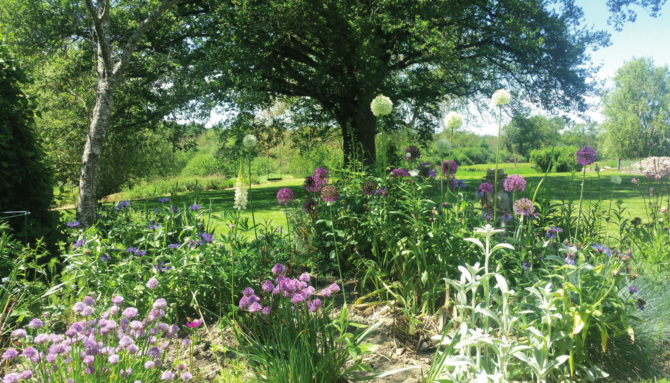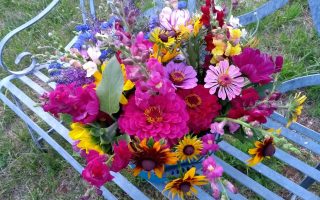The Celtic Herbalist’s Gardens

Where are the celtic gardens?
The Celtic Herbalist’s gardens are developing on the four and a half acres around a farmstead upon one of the limestone plateaux (or causses) in the Midi, near Toulouse, in S.W. France.
This land, with its amazing wealth of flora, was woodland that was settled by the Celts in the 8th century B.C. The Volcae and the Tectosages deposited quantities of treasure in their sacred lakes around here in tribute to their gods. They called themselves Celtae. The Mediterranean peoples, whom they invaded, called them Galli, or ‘strangers’. Julius Caesar wrote “we call them Gauls”.
The Gauls sent their sons and daughters to Wales (U.K.) to train as Druidic physicians, or ‘Ovates’. It is from Wales that we gleaned the Celtic plant list (Materia Medica) that Rhiwallon of Myddfai codified in the 13th century, collating this together with his great Herbal of Celtic remedies.
Works In progress
This is a garden of vegetables, fruit, flowers and herbs arranged in a geometric pattern: three large vegetable beds with four rough circles around them. These comprise: a pool, a fruit mound, a salads’ wheel and a grain circle.
In the centre is a fire pit with a quatrefoil of culinary herbs around it. The pit represents the fire often found in the middle of a Celtic village.
The fruit mound will be jealously guarded by the Spirit the Fruit: a Celtic style manikin on its summit.
This is a memorial garden of tincture beds. It is in memory of Rhiwallon of Myddfai the physician who, in the 13th century, collected the remaining two-thousand year old Celtic remedies in the oral tradition still extant, at that time, in Britain.
The garden comprises nine rectangular beds of medicinal herbs arranged in the medieval fashion with the requisite water feature (here, with pestle and mortar) overflowing into the stone basin.
A Celtic cross, recording Rhiwallon’s life is under the peach tree and a Celtic style bench is being made for under the fig tree.
Preparatory Works
The excavation for the cistern could not be taken down very deeply. At one end we managed only about one foot before hitting the solid rock of the causse. At the other end, we got nearly three feet down. To allow us to store enough water, therefore, the the cistern will have to stand proud of the normal ground level and the south-facing terrace will be a little higher than the east-facing terrace.
Below you can see the start of the pouring of the concrete for the base of the cistern.
This garden is a “Celtic Reflection Garden”.
This is to be a formal rectangular pool with a large Cauldron of Keridwen emptying into the pool for oxygenation. This will be backed by two large fastigiate yews and surrounded by old, hand-cut stones.
The Four Medicine Gardens
a) The Garden of Sleep
This garden is a garden of sedatives and hypnotics. It uses the classic spiral pattern of the late Bronze and Iron Ages and has a loggia around some of it.
b) The Garden of Ease
This Garden is in the shape of the Celtic Cross. I contains mild tranquillising herbs such as Chamomile and Lemon Balm.
This garden will be bounded by two random-stone walls of the farmstead and two straw-bale walls. The walls will be covered in terracotta coloured lime render and will bear black stencilled Celtic markings. The roofs of the loggia will be birch-broom thatch. The trees for this courtyard will be the two European sedative trees: Olive (calms nervous tension), and Lime (Tilia – the favourite French sleep herb) as the central tree by the well.
c) The Garden of Flow
This garden is in the shape of the staff of Aesculapius. It contains Alterative herbs to assist systems’ flows e.g. Cleavers for lymph flow.
d) The Garden of Restoration
This garden contains Trophorestoratives (such as the Tonics and Bitters) and Neurorestoratives e.g. Oats.
[mrb]
Planned Gardens
Below is a list of the gardens planned for the immediate future:
e) The Ancestors’ Ground – This is a Thyme garden of monoliths. Thyme was the herb of death.
f) The Druid’s Pavement – This is a Limestone Pavement with small mounds and pools. It will be plantd with examples of the indigenous and rare bulbiferous flora e.g. Martagon lillies.
g) The Barrow Field – This contains burial mounds, each to be planted in an individual way. It is bisected by a meandering path.
h) The Ceremonial Orchard – This is a pergola of espalliered pome and stone fruit trees. It leads down to the sacred grove.
i) The Sanctuary – This is built in the style of a ‘Celtic sanctuary’, or sacred place and will contain the ambulatory surrounded by its own henge and trees.
j) The Winds of Life – This is a complex star-shaped pergola garden planted to Aromatics. It contains a Celtic wind god.
What is “Celtic” Gardening?
The word Celtic used with gardens obviously does not mean the style of gardens that the Celts had. Theirs were obviously limited to some grains and greens. Our use of the word refers, largely, to plant choice, aesthetic style and spiritual inspiration.
These gardens are being designed and installed by an experienced, RHS qualified Garden Designer, Mr. M. Judd. Mike Judd has designed and installed gardens around the world, from South Africa to the South of France.
The core of Celtic belief, after worship of the sun, was the ‘Cult of Wood and Water’. Water sources were “sacred” to the Celts, just as they are becoming to us, yet again. Hence, Celtic gardens concern themselves with the restoration, conservation and construction of ponds and wetland. These are valuable habitat. If we cannot recreate the other sacred Celtic landscape feature: woodlands, we can at least, make a small pond for fish, fowl, amphibians and insects.
This emphasis on the importance of life in the Celtic Garden extends to plant life, naturally. Where edible cultivars, or certain species are not vital for foodstuffs, and medicines, we use plants, shrubs and trees indigenous to the old Celtic lands. Basically this means France (Gaul), Britain, Spain and Germany, with an emphasis on species that prefer Warm Temperate (or even Arid) climates. Part of the conservation process on our site will include the (legally sanctioned) introduction of endangered French species. Many of these are herbaceous and floriferous and will be emplaced in the small quantity of sward that we allow ourselves in a garden which is largely woodland and wetland. Celtic Gardening is, of course organic.
The Celtic style favours curvilinear shapes and circles, as opposed to rectilinear shapes. Celtic patterns, “La Tene” or earlier, are used used on all things from wall painting to pokerwork on garden artefacts. All artefacts are of a Celtic style themselves and are often the kind of items found in the Celtic period e.g. monoliths (stellae). They are made from stone, wood, or iron – the Celtic age was the Iron Age. Earthworks, from henges to barrows, are used. Garden buildings, from well houses to arbors, will be in rough wood, thatched, etc.
Herbal Remedy of the Week
Your browser is not displaying javascript but you can see The Herbal Remedy of the Week at The Celtic Herbalist
© The Celtic Herbalist 2008
To find out more visit our website www.thecelticherbalist.com
Share to: Facebook Twitter LinkedIn Email
More in centre, courses, decoration, fishing, garden, land, villages
Leave a reply
Your email address will not be published. Required fields are marked *



